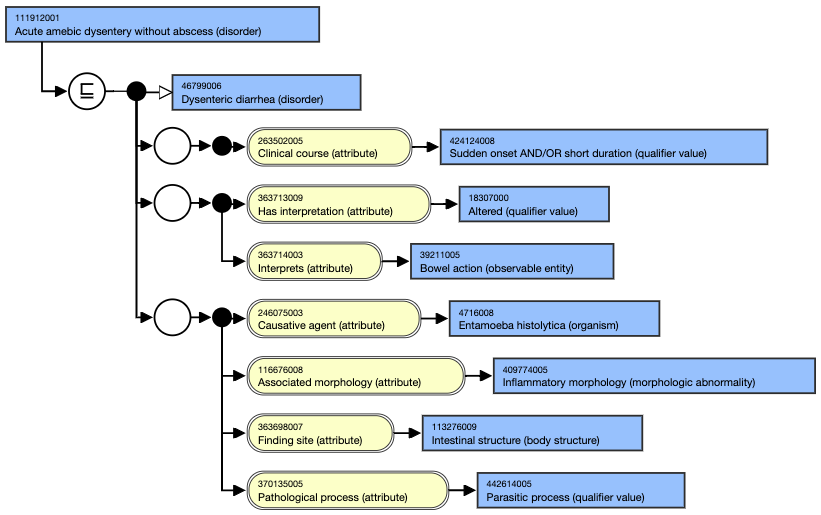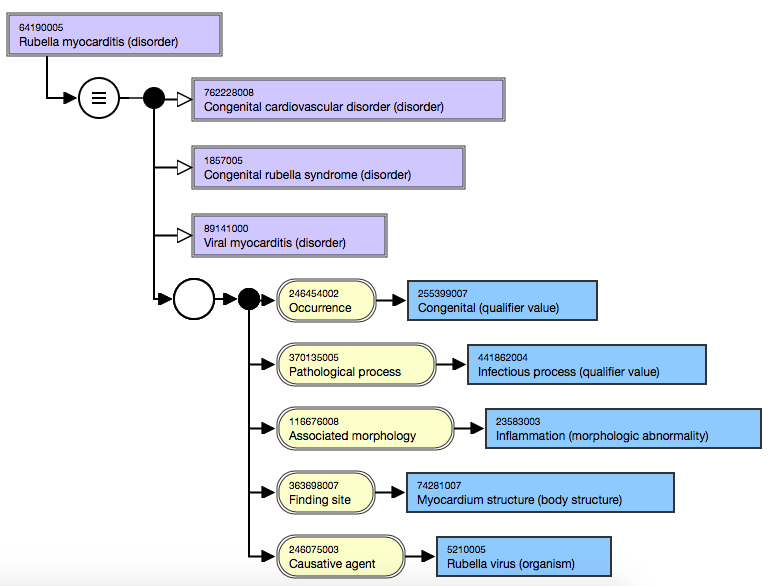
This page describes the grouping of attributes.
A relationship group combines an attribute-value pair with none, one, or multiple attribute-value pairs in order to refine the meaning of a concept.
For example,

Stated view of 18876004 |Pain in finger (finding)| with the Finding site (attribute) and its value of Finger structure (body structure) |
An attribute must be populated with a target value to model a concept.
Relationship groups are needed when modelling:
As with all authoring activities, grouping of attributes is performed in the stated view. |
Ungrouped attributes
An attribute that is not in a relationship group is considered to be in a group on its own. When attributes are not grouped, their meanings are interpreted separately. For example, in the following diagram, the Associated morphology is Hemorrhage, and the Finding site is Uterine structure. However, it cannot be interpreted that the site of the Hemorrhage is the Uterine structure because the two attributes are not grouped.

Inferred view of self-grouped attributes values of Hemorrhage (morphologic abnormality) and Uterine structure (body structure) |
When the attributes are grouped, the relationships imply meaning towards each other. To continue the example above for , the following diagram shows the Associated morphology of Hemorrhage and the Finding site of Uterine structure in a relationship group together. The grouping can be interpreted that the finding site of the hemorrhage is the uterine structure.

Inferred view of grouped attribute values of Hemorrhage (morphologic abnormality) and Uterine structure (body structure) |
Note the difference in the inferred parents between the self-grouped versus grouped attributes. This is explained in more detail below.
Relationship groups refine inheritance, i.e. a grouped set of attributes is more specific than the same attributes that are not grouped. This is important when considering subsumption. The following diagrams demonstrate the impact of grouping or failing to group consistently using the concepts and one of its supertypes,
.
The meaning of the supertype concept, (where the relationships are grouped) is interpreted as a procedure with an excision on the aortic structure. This is because
and
are grouped.

Inferred view of Excision of aorta (procedure) with grouping of attributes |
In the following diagram, the more general supertype concepts, and
are the proximal supertype concepts.
is a logical subtype of
. However, the attributes of the concept
are not grouped. Thus, the classifier interprets the definitions as non-related and
is not inferred as a subtype of
. This is because the attributes in the subtype concept are not grouped, i.e are not explicitly stated. From a machine-processing perspective, each attribute is considered a group on its own; i.e. there is an excision, but nothing else is known about the excision. This results in the concept,
, being interpreted more broadly.

Inferred view of Excision of lesion of aorta (procedure) without grouping of attributes |
In the following diagram the attributes of the concept are grouped. An author that explicitly states that the excision is of a lesion found in the aortic structure, by grouping the attribute-value pairs, provides the necessary information for the classifier. This enables
to be inferred as a subtype of
.

Inferred view of Excision of lesion of aorta (procedure) with grouping of attributes |
Each relationship group should only contain one instance of an attribute. This is because two of the same attributes in a relationship group is not the same as one attribute with one target value that captures the combined meaning of the target values, as illustrated in the following diagram.
Two Finding site attributes are required to support the location of . Each
and its respective target value are placed in a relationship group with the attribute
with its target value of
.

Inferred view of Associated morphology (attribute) with its value of Fracture, closed (morphologic abnormality) in two separate relationship groups |
In the hierarchy, a relationship group is usually a way of combining attributes about a particular method.
In the concept within the following diagram, the relationship groups clarify that there is exploration of the bile duct and excision of the gallbladder. Without the relationship groups, the appropriate relationships between the attributes would be unclear; i.e. the exploration of the bile duct versus gallbladder and the excision of the bile duct versus the gallbladder.

Inferred view of a Procedure hierarchy relationship group: combining attributes around Method (attribute) |
When there is no Method stated, the |
|
In the Clinical finding/Disorder hierarchy:
A relationship group that uses the attributes Associated with, Before, During, After, Due to, Clinical course, or Temporally related to are not grouped with another attribute-value pair; these attributes are "self-grouped". This means, authors place these attributes in a relationship group individually with no other attributes. |

Stated view of a disorder hierarchy concept with Causative agent and Pathological process attributes in the same relationship group |

For concepts, the following four attributes are grouped:
For example, IS A
,
For concepts the following four attributes are grouped:
For example, IS A

Stated view of a concept from the Observable entity hierarchy with self-grouped attributes |